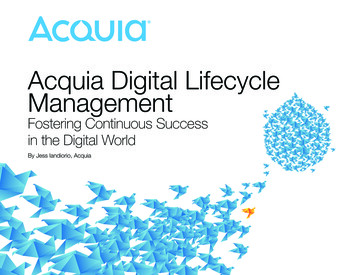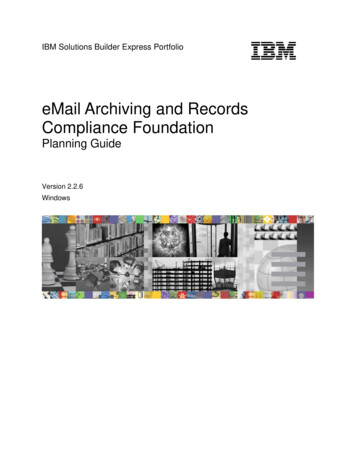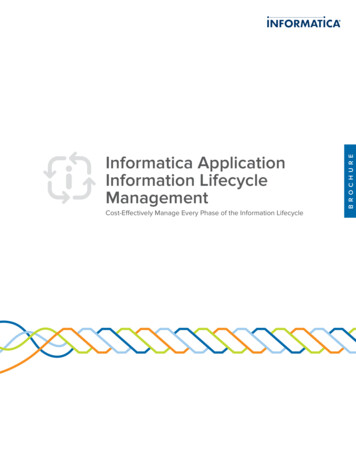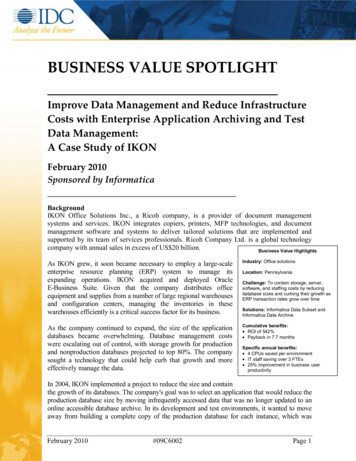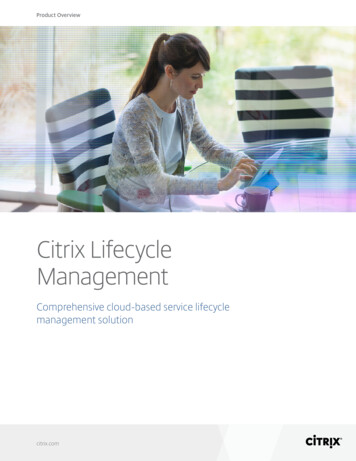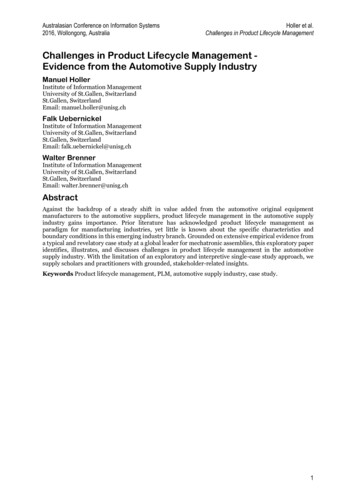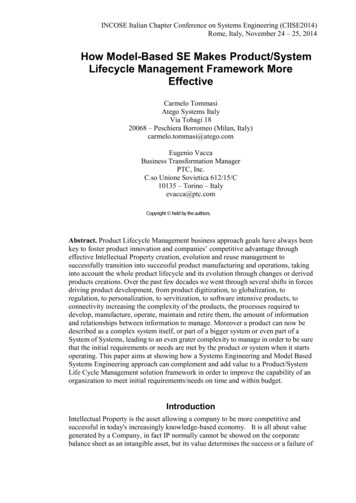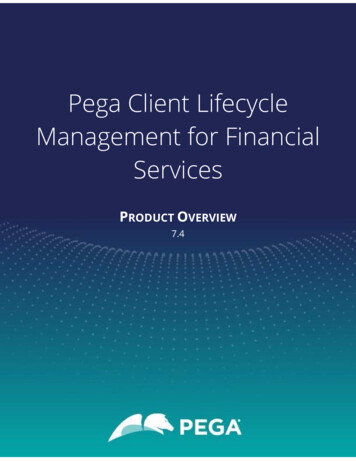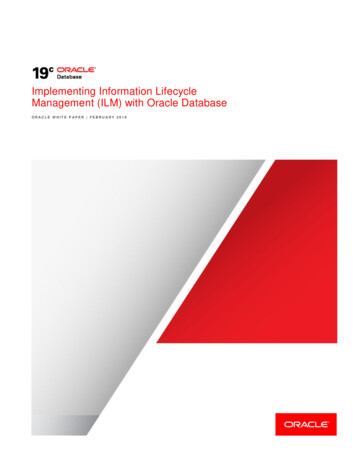
Transcription
Implementing Information LifecycleManagement (ILM) with Oracle DatabaseORAC LE WHITE P APER FE BRU ARY 2019
Disclaimer1Introduction2Information Lifecycle Management3Automating ILM with Oracle Database3Implementing ILM with Oracle Database4Oracle Database ILM Implementation Example5Additional Features for Implementing ILM with Oracle Database8Conclusion10DisclaimerThe following is intended to outline our general product direction. It is intended for information purposes only, and may not beincorporated into any contract. It is not a commitment to deliver any material, code, or functionality, and should not be relied upon inmaking purchasing decisions. The development, release, and timing of any features or functionality described for Oracle’s productsremains at the sole discretion of Oracle.1 P a geImplementing ILM with Oracle Database
IntroductionExponential increases in data volumes are putting enterprise IT infrastructures under severe pressure – from acost, performance, scalability and manageability perspective. It has become imperative to employ more efficientways of storing and managing data to meet the growing demands being placed on IT systems. Dramaticincreases in storage volumes are evident in all types of applications, and enterprise applications are no exception.Although most organizations have long regarded their data as one of their most valuable corporate assets, onlyrecently has the amount of data under management become a major issue. Originally, data was used to helpachieve operational goals to run the business, but as technology capabilities have grown, ever-larger databaseshave become feasible for both operational (OLTP) and analytical (Data Warehouse) applications.Regulatory requirements are also changing how and why data is being retained, as many organizations are nowrequired to retain and control much more information for much longer periods. These requirements often extendbeyond structured data - typically stored in relational databases such as Oracle Database – to semi-structuredand unstructured data such as medical images, videos, photos, contracts, documents, etc. The result is anexplosion in the amount of data that organizations are required to obtain, organize, manage, and store securely(and safely), while still providing easy, scalable, and high-performance access.Consequently, organizations are trying to store fast growing quantities of data for the lowest possible cost whilemeeting increasingly stringent regulatory requirements for data retention and protection. Oracle Databasecontains a rich feature set that can help implement an Information Lifecycle Management (ILM) solution and meetthese new data storage demands, including Data Partitioning, Advanced Row Compression, Hybrid ColumnarCompression, Automatic Data Optimization, Heat Map, Direct NFS Client, Clonedb, SecureFiles, In-DatabaseArchiving and Database File System (DBFS).2 P a geImplementing ILM with Oracle Database
Information Lifecycle ManagementInformation Lifecycle Management (ILM) is the practice of applying policies for the effective management of information throughout itsuseful life. ILM for Oracle Database includes every phase of information from its beginning to its end, and consists of the policies,processes, practices and tools used to align the business value of information with the most appropriate and cost effective ITinfrastructure -- from the time information is created or acquired through its final disposition.Generally speaking, there are FIVE STEPS to implement an ILM strategy:1.Define the Data Classes: For the primary databases that drive your business, identify the types of data in each databaseand where it is stored, and then determine:2. Which data is important, where it is, and what must be retained How this data flows within the organization What happens to this data over time and when is it no longer actively needed The degree of data availability, and protection, that is needed Data retention for legal and business requirementsCreate Logical Storage Tiers: For the data classes that represent the different types of storage tiers available in yourenvironment.3.Define a Lifecycle: A Lifecycle definition describes how data migrates across logical storage tiers during its lifetime. Alifecycle definition comprises one or more lifecycle stages that select a logical storage tier, data attributes such ascompression and read-only, and a duration for data residing on that lifecycle stage. To summarize, a lifecycle definesWHERE to store data, HOW to store data and HOW LONG data should be retained.4.Assign a Lifecycle to Database Tables/Partitions5.Define and Enforce Compliance PoliciesAutomating ILM with Oracle DatabaseWhen implementing an ILM strategy with Oracle Database, organizations typically use Advanced Compression and Data Partitioning tomanually create and deploy a compression and storage tiering solution – a solution that requires organizations to have sharp insightinto data access and usage patterns across applications and tables/partitions.Based upon this insight, DBAs, along with their storage counterparts, can manually compress and/or move data based upon their bestestimations regarding actual data usage, ideally trying to ensure that the most frequently accessed data remains on the highestperformance storage.What has become clear to many organizations, after implementing manual storage tiering solutions, is that the ideal ILM solution isautomated and is not reliant upon the organization’s best guess of data access and usage patterns, but instead uses data usageinformation maintained by the database. The ideal automation solution would provide policy-based classification of data based onusage, greatly simplifying the ILM implementation process.Heat Map and Automatic Data OptimizationTwo features of Oracle Advanced Compression help organizations automate ILM: Heat Map and Automatic Data Optimization (ADO).3 P a geImplementing ILM with Oracle Database
Heat MapHeat Map automatically tracks usage information at the row and segment levels.1 Data modification times are tracked at therow level and aggregated to the block level, and modification times, full table scan times, and index lookup times are trackedat the segment level. Heat Map enables a detailed view of how data is accessed, and how access patterns change over time.Programmatic access to Heat Map data is available through a set of PL/SQL table functions, as well as through datadictionary views. In addition, Oracle Enterprise Manager provides graphical representations of Heat Map data.Automatic Data OptimizationAutomatic Data Optimization (ADO) allows organizations to create policies for data compression and data movement, and toimplement automatic tiering of compression and storage. Oracle Database evaluates ADO policies during the DBA-defineddatabase maintenance window, and uses the information collected by Heat Map to determine which operations to execute. AllADO operations are executed automatically and in the background, with no user intervention required.ADO policies can be specified at the segment or row level for tables and table partitions. In addition to being evaluated andexecuted automatically in the background during the maintenance window, policies can also be evaluated and executedanytime by a DBA, manually or via a script. ADO policies specify what conditions (of data access) will initiate an ADOoperation – such as no access, or no modification, or creation time – and when the policy will take effect – for example,after “n” days or months or years. Custom conditions can also be created by the DBA, allowing other factors to be used todetermine when to move or compress data.Compression TieringADO supports both row-level compression tiering and segment-level compression tiering. Policies can be created to compress inactiverows at the block level (all rows on a block must meet the ADO policy condition before the block is compressed), or to compress entiresegments either with Advanced Row Compression or Hybrid Columnar Compression. All of the compression actions implemented byADO are fully online, and do not block any queries or OLTP transactions.Storage TieringADO supports storage tiering at the tablespace level in the database. As a tablespace reaches a percent used value (set by the DBA)any segments that have qualifying ADO policies will be moved to a target tablespace as specified by the policy; the oldest segments willbe moved first. Once the space in the original tablespace reaches a percent free value (set by the DBA) no more segments are moved.This movement is one direction, meaning that ADO storage tiering is meant to move colder segments from high performance storage toslower, lower cost storage.Implementing ILM with Oracle DatabaseAt the core of an Oracle Database ILM solution is the ability to define multiple data classes and tiers of storage, and assign differentportions of data to different tiers based on the desired cost, performance and security for each portion. This is enabled using DataPartitioning, Advanced Row Compression and Hybrid Columnar Compression, which are briefly described below.Data PartitioningAt the most basic level, IT administrators can implement an Information Lifecycle Management (ILM) strategy by partitioning data basedon the age of the data, and then moving historical partitions to low-cost storage, while keeping partitions that are more active on highperformance storage.Data Partitioning allows a table, index or index-organized table (IOT) to be subdivided into pieces. Each piece of a database object iscalled a partition. Each partition has its own name, and may optionally have its own storage characteristics. From the perspective of adatabase administrator, a partitioned object has multiple pieces, which can be managed either collectively or individually. This gives the1Database rows are stored in database blocks, which are grouped in extents. A segment is a set of extents that contains all th e data for a logical storage structurewithin a tablespace, i.e. a table or partition.4 P a geImplementing ILM with Oracle Database
administrator considerable flexibility in managing the partitioned object. However, from the perspective of the application, a partitionedtable is identical to a non-partitioned table; no modifications to application queries are necessary when accessing a partitioned table.It is not unusual for partitioning to improve the performance of queries or maintenance operations by an order of magnitude. Moreover,partitioning can greatly reduce the total cost of data ownership, enabling a “tiered archiving” approach of keeping older but still relevantinformation online on lower cost storage devices.Advanced Row CompressionAdvanced Row Compression, a feature of Advanced Compression, uses a unique compression algorithm specifically designed to workwith database tables in all types of applications. The algorithm works by eliminating duplicate values within a database block, evenacross multiple columns.The compression ratio achieved with a given data set depends on the nature of the data being compressed. In general, organizationscan expect to reduce their storage space consumption 2x to 4x by using Advanced Row Compression. That is, the amount of spaceconsumed by compressed data will be two to four times smaller than that of the same data without compression.Hybrid Columnar CompressionHybrid Columnar Compression (HCC) enables higher levels of data compression and provides enterprises with tremendous costsavings. Average compression ratios can range from 6x to 15x depending on which Hybrid Columnar Compression level isimplemented – real world customer benchmarks have resulted in storage savings of up to 50x and more.Oracle’s Hybrid Columnar Compression technology utilizes a combination of both row and columnar methods for storing data. WhileHCC compressed data can be modified using conventional Data Manipulation Language (DML) operations, such as INSERT andUPDATE – HCC is best suited for applications with no, or very limited DML update operations. The SQL INSERT statement, without theAPPEND hint, can use HCC (without degrading the compression level), and array inserts from programmatic interfaces such asPL/SQL and the Oracle Call Interface (OCI) can use HCC.HCC Compression LevelsHCC Warehouse compression (also referred to as Query compression) has been optimized on Exadata storage toincrease scan query performance by taking advantage of the smaller number of blocks on disk. HCC ArchiveCompression is optimized to maximize storage savings, typically achieving a compression ratio of 15:1 (15x).Hybrid Columnar Compression is available for use on Exadata, SuperCluster, Pillar Axiom, FS1, The Oracle DatabaseAppliance (ODA) and Sun ZFS Storage Appliance (ZFSSA) storage hardware.Oracle Database ILM Implementation ExampleThe remainder of this document will discuss how the features of Oracle Database can implement the FIVE STEPS of an ILM strategythat are defined earlier in this document. These steps will be reviewed as to how and where they fit into an Oracle Database ILMsolution – as well as which Oracle Database features can be utilized.Steps 1 to 3: Define Data Classes, Logical Storage Tiers and Information LifecycleRelated Oracle Features:Data Partitioning, Advanced Row Compression and/or Hybrid Columnar Compression Define the Data ClassesThis step involves looking at all the data in your organization. This analysis requires organizations to understandwhich objects are associated with which applications, where those objects are located (on what class of storage),whether the objects have been compressed, and the granularity of the object (table vs. partition).5 P a geImplementing ILM with Oracle Database
Create Logical Storage TiersThis step identifies and creates logical storage tiers, utilizing higher cost high performance storage and lower costhigh capacity storage. Define a LifecycleThe Lifecycle definition describes how data migrates across logical storage tiers during its lifetime. A lifecycledefinition includes one or more lifecycle stages that select a logical storage tier, data attributes such as compressionand/or read only, and a retention period for data residing on that lifecycle stage.The lifecycle brings together the information/activities in STEPS 1 and 2 to allow DBA’s to plan WHERE to store data (the logicalstorage tiers), HOW to store data (the data granularity and whether to compress the data) and HOW LONG data should be retained(which also helps determine how to compress the data).Utilizing the planning from STEP 3, the diagram below (figure 1) shows how the most active data can be located on a high performancetier, and the less active / historical data on lower-cost tiers (and begins to associate compression levels to the various storage tiers).Using Oracle Data Partitioning, the most active data partitions can be placed on faster, higher performance storage, while less activeand historical data can be placed on lower cost storage. Data compression can also be applied as desired on a partition-by-partitionbasis. With this combination of features, the business is meeting all of its performance, reliability, and security requirements, but at asignificantly lower cost than in a configuration where all data is located on one tier of storage.With OLTP applications, organizations can use Advanced Row Compression (previously named OLTP Table Compression) for themost active tables/partitions, to ensure that newly inserted or updated data will be compressed as DML operations are performedagainst the active tables/partitions. For cold or historic data (tables/partitions with no or limited DML update activity) within the OLTPapplication, organizations can use either Warehouse or Archive Hybrid Columnar Compression (assuming they are using storage thatsupports HCC).Define multiple tiers of storage, and assigndifferent portions of your data to different tiersbased on the desired cost, performance andsecurity for each portionData is compressed with Advanced RowCompression and/or HCC across storagetiers -- 3x to 15x compression is typicaldepending on the type of compression usedFigure 1. Compression and storage tiering.Prior to Oracle Database 12c, organizations implemented both the storage tiering and compression tiering of their data manually, basedupon their knowledge of the database. With Oracle Database, storage tiering and compression can be automated, reducing therequirement for organizations to have deep insights into their data access/usage patterns. This information can now be provided by thedatabase itself, using the Advanced Compression Heat Map capability, and ILM policies can be enforced automatically by the databaseusing Automatic Data Optimization (ADO).6 P a geImplementing ILM with Oracle Database
Steps 4 and 5: Assign a Lifecycle to Tables/Partitions and Define and Enforce CompliancePoliciesRelated Oracle Features:Data Partitioning, Advanced Row Compression and/or Hybrid Columnar Compression, Automatic Data Optimization and Heat MapImplementing an automated compression and storage tiering solution using Automatic Data Optimization and Heat Map isstraightforward, as the example below will show.In this example, we have a table named “orders” that was initially created without any compression. We have turned on Heat Map andare tracking the usage of this table over time. It is the intention, of our organization, to wait until the majority of the post-load activities,that are performed initially on the table, complete and then the table be compressed, using Advanced Row Compression, withoutmoving the table (meaning the table will be compressed in place). Once the tables cools down (with no or few DML updates), andbegins to be primarily used for reports/queries (LESS ACTIVE tier), we will then compress the table with HCC QUERY HIGH. Whenthe table has become colder and is only occasionally queried (used for reporting purposes), we will then compress it even further withHCC ARCHIVE HIGH.The example uses the ADO condition “no modification”.The ADO policy below enables Advanced Row Compression, and since we specified “row” versus “segment” level compression, thetables’ blocks will be individually compressed when all the rows on the block meet the ADO compression policy that is specified (thatbeing AFTER 2 DAYS OF NO MODIFICATION)ALTER TABLE orders ILM ADD POLICYROW STORE COMPRESS ADVANCED ROWAFTER 2 DAYS OF NO MODIFICATION;This policy allows the post-load activity to subside on the table before compression is implemented. For organizations with SLA’saround the load times, this allows the table to be created and populated as quickly as possible, before implementing compression.Compression can be specified at the “row” level or the “segment” level. Row level allows the table to be compressed in place, blockby-block, as all the rows on a block meet the ADO policy condition. Tables/partitions can also be compressed at the segment level,this means the entire segment is compressed at the same time.The next policy, that was specified by the DBA, will be automatically enforced by the database (at the segment level) when Heat Mapdetermines there has been no data modifications for 90 days. The policy changes the compression level of the table to a higher levelof compression (HCC QUERY HIGH) when the data is being used primarily for queries/reporting.ALTER TABLE orders ILM ADD POLICYCOLUMN STORE COMPRESS FOR QUERY HIGH SEGMENTAFTER 90 DAYS OF NO MODIFICATION;Changing the compression from Advanced Row Compression, to Hybrid Columnar Compression (HCC QUERY HIGH), occurs duringa maintenance window after the specified ADO policy criteria has been met.When this table further “cools down” additional storage and performance gains can also realized when ADO automaticallycompresses the data to the highest level possible (HCC ARCHIVE HIGH) with Oracle. In this example, this data is still needed forquery purposes, but is no longer being actively modified (no or few DML updates) and only occasionally queried or used for reporting.This cold/historic data is an ideal candidate for HCC ARCHIVE HIGH compression.After 180 days of no modification being made to the data, this ADO policy will be applied.ALTER TABLE orders ILM ADD POLICYCOLUMN STORE COMPRESS FOR ARCHIVE HIGH SEGMENTAFTER 180 DAYS OF NO MODIFICATION;7 P a geImplementing ILM with Oracle Database
With the final ADO compression tiering policy criteria being satisfied, the data is now compressed to the HCC ARCHIVE HIGH leveland could be moved to lower cost storage (Tier 2). This allows active data to remain on higher performance tiers (ACTIVE tier) andallows the historic data, which remains online, to still be accessed by applications as needed and ensures a smaller footprint for thehistoric data (LESS ACTIVE tier).This example uses the “best practice” approach of compressing using both Advanced Row Compression and Hybrid ColumnarCompression. Advanced Row Compression (as well as Heat Map and ADO) are features of Advanced Compression. While HCC doesnot require Advanced Compression, it does have other requirements2, please see here for the Oracle HCC White Paper. Whilecompression tiering best practice does include the use of HCC, if an organization does not have access to HCC, then they would useonly Advanced Row Compression in their ADO policies.ADO-based storage tiering (Tier To) is not based upon the ADO condition clause (i.e. after “x” days of NO MODIFICATION) as iscompression tiering and instead, is based upon tablespace space pressure. The justification for making storage tiering dependent on"space pressure" is exactly as you might imagine, the belief that users will want to keep as much data as possible on their highperformance (and most expensive) storage tier, and not move data to a lower performance storage tier until it is absolutely required.The exception to the storage pressure requirement are storage tiering policies with the 'READ ONLY' option, these are triggered by aheat-map based condition clause.The value for the ADO parameter TBS PERCENT USED specifies the percentage of the tablespace quota when a tablespace isconsidered full. The value for TBS PERCENT FREE specifies the targeted free percentage for the tablespace. When the percentageof the tablespace quota reaches the value of TBS PERCENT USED, ADO begins to move segments so that percent free of thetablespace quota approaches the value of TBS PERCENT FREE. This action by ADO is a best effort and not a guarantee.You can set ILM ADO parameters with the CUSTOMIZE ILM procedure in the DBMS ILM ADMIN PL/SQL package, for example:BEGINDBMS ILM ADMIN.CUSTOMIZE ILM(DBMS ILM ADMIN.TBS PERCENT USED,85):DBMS ILM ADMIN.CUSTOMIZE ILM(DBMS ILM ADMIN.TBS PERCENT FREE,25):END;In this example, when a tablespace reaches the fullness threshold (85%) defined by the user, the database will automatically movethe coldest table/partition(s) in the tablespace to the target tablespace until the tablespace quota has at least 25 percent free. Ofcourse this only applies to tables and partitions that have a "TIER TO" ADO policy defined (see example below). This frees up spaceon your tier 1 storage (ACTIVE tier) for the segments that would truly benefit from the performance while moving colder segments,that don’t need Tier 1 performance, to lower cost Tier 2 storage (LESS ACTIVE/COLD Tier)ALTER TABLE orders ILM ADD POLICY TIER TO lessactivetbs;In this simple ILM example, Oracle Database automatically evaluated the ADO policies to determine when data was eligible to bemoved to a higher compression level, and when data was eligible to be moved to a different tablespace. This ensures data accessibilityand performance, while reducing the storage footprint even further – with no additional burden placed on database administrators orstorage management staff.Additional Features for Implementing ILM with Oracle DatabaseOracle Database contains a rich set of features to enhance and optimize an Information Lifecycle Management (ILM) solution,including:2Note that Hybrid Columnar Compression is only available with Oracle Database on Exadata or with specific Oracle Storage.8 P a geImplementing ILM with Oracle Database
Direct NFS Client (dNFS)Standard NFS client software, provided by the operating system, is not optimized for Oracle Database file I/O access patterns. WithOracle Database 11g and later releases, organizations can configure Oracle Database to access NFS V3 (or V4 with Oracle Database12c) NAS devices directly using Oracle Direct NFS Client, rather than using the operating system kernel NFS client. Oracle Databasewill access files stored on the NFS server directly through the integrated Direct NFS Client, eliminating the overhead imposed by theoperating system kernel NFS. These files are also accessible via the operating system kernel NFS client thereby allowing seamlessadministration. CloneDBCloneDB allows the creation of databases using “copy on write” technology to quickly create database clones. CloneDB requires thateach clone database use the Direct NFS Client and that a backup of the source database be available on Direct NFS Client-mountedstorage. There must also be enough storage for that backup and for each database block that changes in each of the clonedatabase(s). The time to create the clone is very quick because the source database’s data is not copied to create the clone – only fileheader information is copied – and when creating multiple clones from a single source database the total storage required can besignificantly less than with traditional full size database copies. This allows the organization to easily keep development, test and QAdatabases available and in sync quickly while using significantly less storage. SecureFilesSecureFiles is designed to deliver high performance for files stored in Oracle Database, comparable to that of traditional file systems,while retaining the advantages of Oracle Database. SecureFiles was first introduced in Oracle Database 11g, and enables a majorparadigm shift for storing and managing files. Traditionally, relational data is stored in a database while unstructured data is stored asfiles in file systems; with SecureFiles, you can store relational and file data together in Oracle Database and deliver high performancewhile also implementing a unified security model, a unified backup and recovery infrastructure, and enabling all the other features ofOracle Database for both structured and unstructured data. See also Database File System below. Database File System (DBFS)Database File System (DBFS) implements a standard file system interface for files stored in Oracle Database. With this interface,storing files in the database is no longer limited to programs specifically written to use BLOB and CLOB programmatic interfaces - filesin the database can now be transparently accessed using any operating system (OS) program that acts on files. DBFS makes it easy tostore all your files in your database. In-Database ArchivingIn-Database Archiving allows applications to archive rows within tables by marking them as inactive. This feature can meet compliancerequirements for data retention while hiding archived data from current application usage. Archived rows can be displayed using SQLstatements that specifically make them visible, and the rows can be re-activated if needed because they still reside in the original table.These archived rows can also be compressed to reduce their storage usage and can be incorporated into an ILM strategy at thesegment level.9 P a geImplementing ILM with Oracle Database
ConclusionInformation Lifecycle Management (ILM) enables organizations to understand how their data is accessed over time, and manage thedata compression and storage tiering accordingly. However, most ILM solutions for databases lack two key capabilities – automaticclassification of data and automatic data compression and movement across storage tiers.The Heat Map and Automatic Data Optimization features of Advanced Compression, with Oracle Database, provide comprehensiveand automated ILM capabilities that minimize costs while maximizing performance. In combination with its comprehensive compressionfeatures, Oracle Database provides an ideal platform for implementing Information Lifecycle Management for all of your database data.Oracle Corporation, World HeadquartersWorldwide Inquiries500 Oracle ParkwayPhone: 1.650.506.7000Redwood Shores, CA 94065, USAFax: 1.650.506.7200C ON N EC T W IT H U t 2019, Oracle and/or its affiliates. All rights reserved. This document is provided for information purposes only, and thecontents hereof are subject to change without notice. This document is not warranted to be error-free, nor subject to any otherwarranties or conditions, whether expressed orally or implied in law, including implied warranties and conditions of merchantability orfitness for a particular purpose. We specifically disclaim any liability with respect to this document, and no contractual obligations areformed either directly or indirectly by this document. This document may not be reproduced or transmitted in any form or by any means,electronic or mechanical, for any purpose, without our prior written permission.oracle.comOracle and Java are registered trademarks of Oracle and/or its affiliates. Other names may be trademarks of their respective owners.facebook.com/oracleIntel and Intel Xeon are trademarks or registered trademarks of Intel Corporation. All SPARC trademarks are used under license andare trademarks or registered trademarks of SPARC International, Inc. AMD, Opteron, the AMD logo, and the AMD Opteron logo aretrademarks or registered trademarks of Advanced Micro Devices. UNIX is a registered trademark of The Open Group. 021910 P a g eImplementing ILM wi
Information Lifecycle Management 3 Automating ILM with Oracle Database 3 Implementing ILM with Oracle Database 4 Oracle Database ILM Implementation Example 5 Additional Features for Implementing ILM with Oracle Database 8 Conclusion 10 Disclaimer The following is intended to outline our general product direction. It is intended for information .
